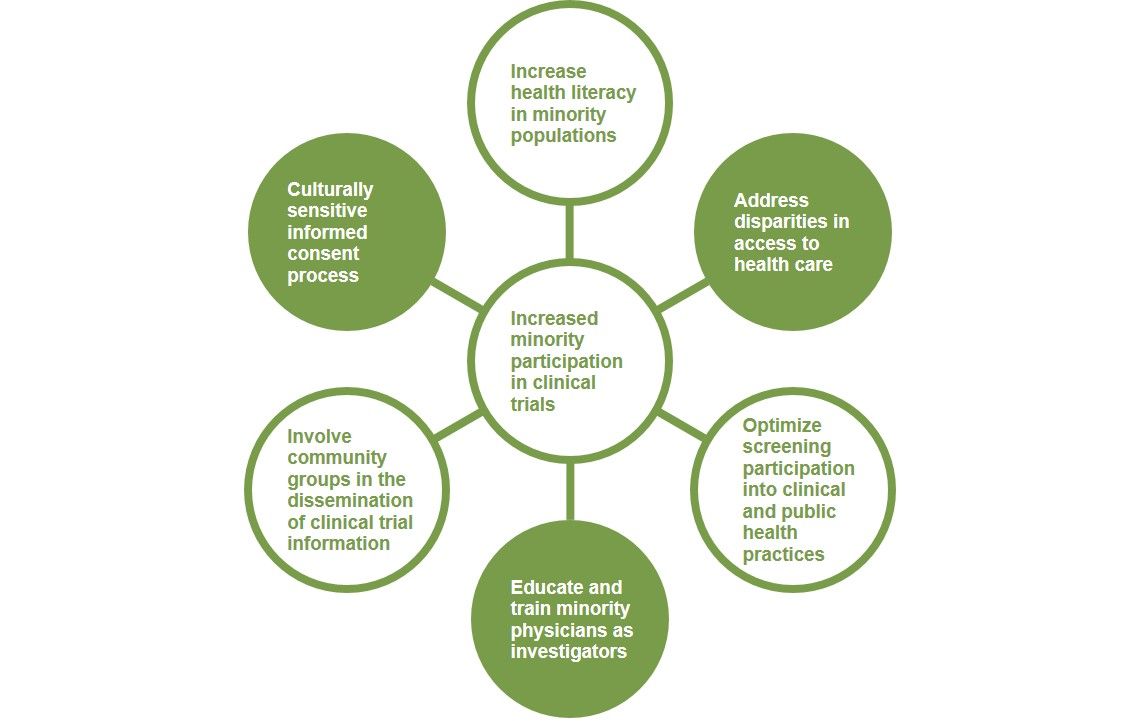Improving Minority Recruitment in Clinical Trials
Promising new approaches to optimize data and outcomes.
Despite the well-established differences in disease incidence and responses to certain drugs between racial and ethnic groups, clinical trials often fail to mirror ‘real world’ patient populations.[1][2] This increases the risk of unexpected adverse events (AEs) when products are eventually approved, with one study finding that 6.5 % of emergency hospital admissions were due to AEs.[3] For example, consider that African Americans comprise 12 % of the population in the United States, but account for only 5 % of clinical trial participants. Hispanics account for 16 % of the total population but comprise just 1 % of clinical trial populations.
Clinical trials that do not represent the full diversity of the population may also potentially fail to identify particular groups who could benefit from experimental drugs. While African American men are twice as likely to die from prostate cancer as Caucasians, they represent only 4 % of participants in prostate cancer clinical trials.[4] Similarly, cancer is the leading cause of death for the Asian-American population, yet Asian Americans represent less than 3 % of clinical trial participants.
Against this backdrop, the need for improved recruitment of minorities to clinical trials is clear. Key challenges to overcome include:
- Lack of access to affordable healthcare insurance for many low-income populations, which may include minorities, can limit interactions with healthcare professionals, reducing the chance of becoming aware of clinical trials and their potential as a valuable care option
- Some minorities may work in hourly jobs that provide less scheduling flexibility, and raises the likelihood of losing pay to attend clinical trial appointments
- Less than 1 % of the U.S. population participates in clinical trials, and yet 72 % say they would participate in a clinical trial if recommended by their doctor.[5] There is a need for improved community education about the realities and patient protections of current clinical research protocols.
In response, clinical trial sites have identified a range of best practices for recruiting minority participants (Figure 1). Multifactorial approaches include identifying and working with sites that have minority and multilingual staff, making the environment more welcoming for minorities and individuals whose first language is not English. To connect with patients in minority communities and win their trust, communicating through physicians and clinics is only a first step. Popular community gathering locations should be considered as part of a recruitment plan, along with participating in local events such as health fairs. To be effective, handing out flyers or posting ads is not enough. The best results come from face-to-face engagements, where study staff can take an opportunity to educate people about clinical research, answer questions, allay fears and talk about the value of participation. Specific study information can also be communicated through targeted media. Furthermore, clinical trials can be made more accessible for patients by offering assistance with transportation, childcare and dependent care.
Figure 1: Multifactorial challenges require multifactorial solutions

When partnering with biopharma study sponsors, it is essential to clarify the level of commitment to a specific study or program requiring targeted minority recruitment, and be willing to try innovative approaches and provide additional resources to attain enrollment targets. Decision-making should involve senior leadership as well as diversity officers, with an emphasis on the importance of long-term relationships with external advocacy groups, patient advocacy groups and medical associations. The best practice is to build an internal infrastructure to address minority recruitment rather than repeatedly setting up ad hoc project teams.
In conclusion, the approaches described above can help build a dialogue with target minority populations to improve study sponsors’ understanding and accommodation of varying lifestyles and specific population needs within study protocols. This is an essential step towards ensuring that clinical trial populations more closely reflect the real world where new drugs will be used. Equally important, these approaches can also benefit minority patients by improving their awareness and access to clinical trials as a valuable care option.
Bernadette Tosti, Senior Director, Head of Patient Recruitment Programs, Quintiles
[1] www.fda.gov/downloads/ScienceResearch/SpecialTopics/WomensHealthResearch/UCM334959.pdf
[2]http://www.ncbi.nlm.nih.gov/pubmed/15692274
[3]http://www.ncbi.nlm.nih.gov/pubmed/15231615
4http://www.cancer.gov/about-nci/organization/crchd/cancer-health-disparities-fact-sheet#q9
[5] Research!America National Poll on Clinical Research conducted in partnership with Zogby Analytics, May 2013; N=1,006
Improving Relationships and Diversifying the Site Selection Process
April 17th 2025In this episode of the Applied Clinical Trials Podcast, Liz Beatty, co-founder and chief strategy officer, Inato, discusses a number of topics around site engagement including community-based sites, the role of technology in improving site/sponsor relationships, how increased operational costs are impacting the industry, and more.
Behind the Buzz: Why Clinical Research Leaders Flock to SCOPE Summit
February 7th 2025In this episode, we meet with Micah Lieberman, Executive Conference Director for SCOPE Summit (Summit for Clinical Ops Executives) at Cambridge Innovation Institute. We will dive deep into the critical role of collaboration within the clinical research ecosystem. How do we bring together diverse stakeholders—sponsors, CROs, clinical trial tech innovators, suppliers, patients, sites, advocacy organizations, investors, and non-profits—to share best practices in trial design, program planning, innovation, and clinical operations? We’ll explore why it’s vital for thought leaders to step beyond their own organizations and learn from others, exchanging ideas that drive advancements in clinical research. Additionally, we’ll discuss the pivotal role of scientific conferences like SCOPE Summit in fostering these essential connections and collaborations, helping shape the future of clinical trials. Join us as we uncover how collective wisdom and cross-industry partnerships are transforming the landscape of clinical research.
Landmark Phase III Trial Shows Keytruda Significantly Improves Event-Free Survival in LA-HNSCC
April 28th 2025Interim KEYNOTE-689 trial data show that perioperative Keytruda significantly lowers the risk of disease progression or recurrence in resectable, locally advanced head and neck squamous cell carcinoma, marking the first major clinical advance for this patient population in more than two decades.